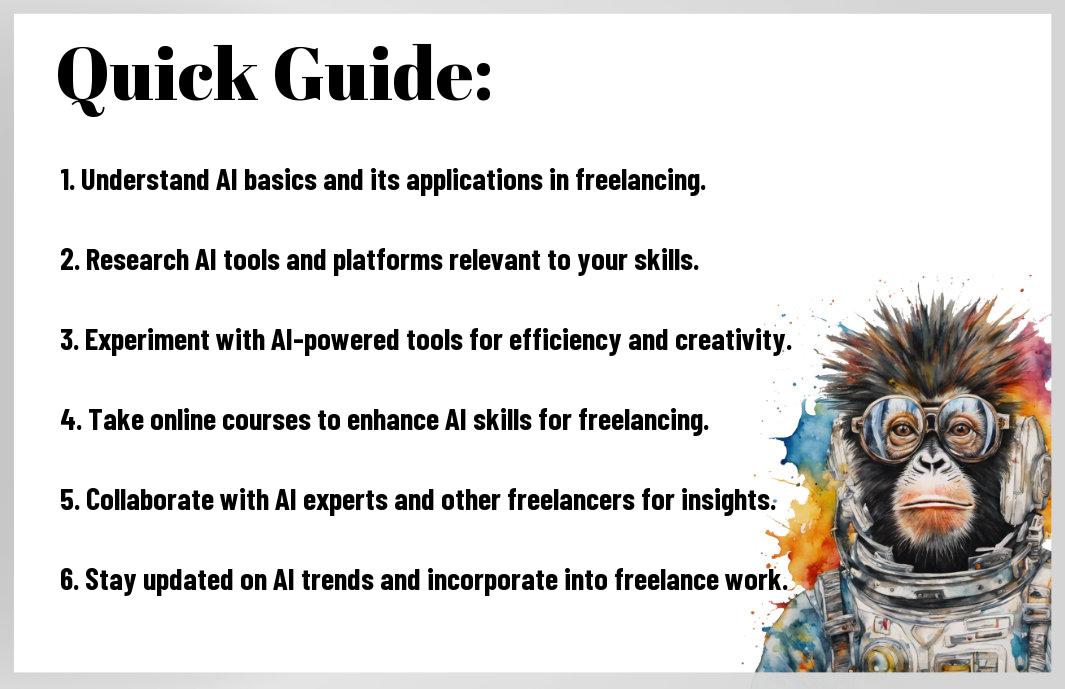Many freelancers are unaware of the powerful ways in which artificial intelligence can revolutionize their work and boost their productivity. In this beginner’s guide, we will explore the various applications of AI that can help freelancers streamline their tasks, improve their decision-making process, and ultimately, enhance their overall performance. By harnessing the potential of AI tools and technologies, freelancers can stay ahead of the curve and thrive in today’s fast-paced digital economy.
Understanding Types of AI for Freelancers
The advancement of Artificial Intelligence (AI) has opened up new opportunities for freelancers across various industries. To fully leverage the power of AI, it is necessary to understand the different types of AI technologies available. Below is a breakdown of the three main types of AI: Narrow or Weak AI, General or Strong AI, and Superintelligence.
| Narrow or Weak AI | General or Strong AI |
| Specialized in performing specific tasks | Has the ability to understand, learn, and apply knowledge across different domains |
| Examples include chatbots and virtual assistants | Aims to replicate human intelligence and reasoning |
| Can significantly improve efficiency and productivity | Considered the holy grail of AI |
| More common in practical applications | Still largely theoretical and experimental |
Narrow or Weak AI
Now, Narrow AI, also known as Weak AI, is designed to perform specific tasks or solve particular problems. It is the most prevalent form of AI in use today, powering various applications such as chatbots, recommendation systems, and image recognition tools.
General or Strong AI
Clearly, General AI, also referred to as Strong AI, aims to develop machines with human-like intelligence – the ability to understand, learn, and apply knowledge across different domains. While still largely in theoretical research, General AI holds the potential to revolutionize the way freelancers work and interact with technology.
Another critical aspect of General AI is its capacity for reasoning, problem-solving, and self-improvement, making it a highly sought-after goal in the field of artificial intelligence.
Superintelligence
Clearly, Superintelligence refers to AI systems that surpass human cognitive capabilities in every way – including creativity, social skills, and general wisdom. While the concept of Superintelligence remains largely speculative, its implications for freelancers and society as a whole are profound.
The creation of Superintelligent AI poses both exciting possibilities and significant ethical concerns, highlighting the importance of responsible AI development and deployment in the freelance industry and beyond.
Tips for Getting Started with AI as a Freelancer
Clearly, incorporating AI into your freelance business can boost productivity and efficiency. To make the most of this technology, there are a few key tips to keep in mind:
Identifying Your Needs
If you are new to AI, start by identifying areas in your workflow where AI can help streamline tasks or improve outcomes. By understanding your specific needs, you can target the right solutions that will have the most impact on your work.
Choosing the Right AI Tools
Now, with a clearer idea of your requirements, research and evaluate different AI tools available in the market. Look for tools that are user-friendly, offer good support, and align with your budget. It’s crucial to choose tools that fit seamlessly into your workflow and can easily integrate with your existing systems.
Identifying your needs and choosing the right AI tools can set the foundation for a successful integration of AI into your freelancing business. By taking the time to understand what you require and selecting the most suitable tools, you can maximize the benefits of AI and propel your freelance career to new heights.
Setting Realistic Expectations
Clearly, AI is a powerful technology, but it is not a magic bullet that will solve all your problems overnight. It’s important to have realistic expectations about what AI can and cannot do for your freelance business. Set achievable goals and understand that AI is a tool to enhance your capabilities, not replace them entirely.
A realistic approach to utilizing AI in your freelance work will help you appreciate its benefits while also acknowledging its limitations. By setting achievable goals and understanding the technology’s capabilities, you can leverage AI effectively in your business endeavors.
A Step-by-Step Guide to Implementing AI in Your Freelance Business
| Assessing Your Workflow | Automating Repetitive Tasks |
| Analyze your current workflow to identify tasks that can be automated or optimized using AI technology. | Implement AI tools to streamline repetitive tasks such as invoicing, scheduling, or data entry. |
Assessing Your Workflow
After familiarizing yourself with AI technology, the first step is assessing your workflow to pinpoint areas where AI can be integrated to improve efficiency and productivity.
Automating Repetitive Tasks
Implementing AI to automate repetitive tasks can save you valuable time and allow you to focus on more complex and creative aspects of your freelance work.
Plus, automating repetitive tasks can reduce the risk of human error and ensure consistency in your deliverables, leading to higher client satisfaction and retention.
Enhancing Client Communication
Clearly communicate with your clients about the AI tools you are using to enhance your services and improve communication and project management.
It is imperative to involve clients in the process and demonstrate how AI can benefit them by providing more accurate results and faster turnaround times.
Key Factors to Consider When Using AI as a Freelancer
Keep these vital factors in mind when leveraging AI tools as a freelancer:
- Data Quality and Security
- Ethics and Bias
- Continuous Learning and Improvement
This holistic approach will help you optimize the use of AI in your freelance endeavors. For more insights on how AI can enhance your freelancing career, check out Unleashing AI Potential: The Lucrative Landscape of Side Hustles.
Data Quality and Security
There’s no denying that data quality and security are paramount when it comes to leveraging AI as a freelancer. Ensuring the accuracy, reliability, and protection of data is crucial for the success of any AI-driven project.
Ethics and Bias
Data ethics and bias are critical considerations when using AI. It’s vital to be aware of the potential biases in AI algorithms and take steps to mitigate them. This includes ensuring fairness, transparency, and accountability in your AI applications.
Continuous Learning and Improvement
Continuous learning is key to staying relevant in the rapidly evolving field of AI. As a freelancer, investing in your skills and staying updated with the latest developments in AI technologies is crucial for long-term success.
Improvement in AI tools and techniques is a continuous process. By actively seeking opportunities to enhance your knowledge and skills, you can maximize the benefits of AI in your freelance projects.
Weighing the Pros and Cons of AI for Freelancers
Not surprisingly, the rise of AI technology has brought both advantages and challenges for freelancers looking to leverage its capabilities. Let’s take a closer look at the pros and cons of integrating AI into your freelance business:
| Pros | Cons |
| Increased Efficiency | Job Replacement |
| Cost Savings | Dependence on Technology |
| Scalability | |
| Enhanced Creativity | |
| Improved Decision Making |
Increased Efficiency and Productivity
One of the key benefits of using AI as a freelancer is the significant increase in efficiency and productivity. AI tools can automate repetitive tasks, analyze data quickly, and provide valuable insights, allowing freelancers to focus on more high-value work.
Cost Savings and Scalability
Increased cost savings and scalability are additional advantages of incorporating AI into freelance work. AI tools can streamline processes, reduce overhead costs, and easily adjust to fluctuating work demands, making it a cost-effective solution for freelancers.
For instance, freelancers can utilize AI-powered project management tools to automate admin tasks, freeing up more time to focus on client work. Additionally, AI can help freelancers scale their business by handling a larger volume of work efficiently.
Job Replacement and Dependence on Technology
Cost concerns and the fear of job replacement are common cons associated with AI in freelancing. Some worry that AI technologies could automate jobs traditionally done by freelancers, leading to a decrease in demand for certain services. Additionally, there is a legitimate concern about becoming too dependent on AI for crucial aspects of freelance work.
It is vital for freelancers to strike a balance between leveraging the benefits of AI technology and maintaining their unique skills and expertise to avoid being replaced by automated solutions.
Learn Chatgpt- The AI Solutions Method Book: A Step-By-…
Conclusion
Upon reflecting on the comprehensive beginner’s guide to leveraging AI for freelancers, it is evident that integrating AI tools can greatly enhance productivity, efficiency, and the quality of work for freelancers. By embracing the possibilities that AI offers, freelancers can streamline their workflows, optimize their time management, and unlock new opportunities for growth and success in the ever-evolving gig economy.





